I have been thinking about adding a Chinatown section to my LEGO Modular Buildings layout for quite some time now, and when the LEGO Chinese New Year sets were released, the idea solidified even further. Many LEGO fans use #70620 LEGO Ninjago City and #70657 LEGO Ninjago City Docks for their Asian neighborhood, but because I only have one long shelf for my Modulars, I wanted something more compact. Below, I will discuss the project in detail, share pictures, and explain some of the ups and downs of the design and building process. I thought it might help someone else who is exploring a similar project.
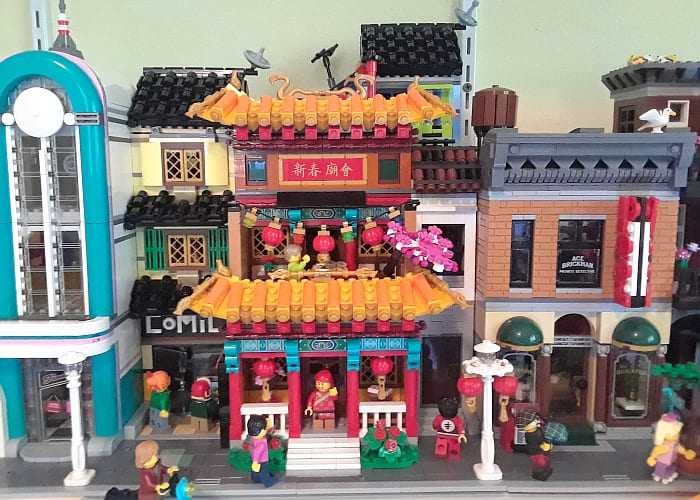
LEGO MODULAR CHINATOWN – THE IDEA: The official LEGO Modular Buildings collection is nice, but the buildings are all kind of the same style; buildings you can find in big cities in Europe and North America. I wanted to spice up my street view by adding buildings from other cultures, but still tying them in with the rest of the street. Much like how you would find neighborhoods from other cultures in big cities with their own unique flair.
LEGO MODULAR CHINATOWN – THE RULES: As Chinatown was going to be a structure that’s meant to fit with the LEGO Modular Buildings, it had to stay within the rules of the Modulars. These might be considered limiting, but they also provide a structure that helps with solidifying ideas. One of the rules is that the structure must fit a 32×32-stud baseplate. Some of the official LEGO Modulars split this layout into two 16×32 baseplates, and the #10255 LEGO Modular Assembly Square uses a 32×32 plus a 16×32 baseplate, but the bottom line is that foundation should be one of those measures, with 32×32 studs as the most commonly used layout.

Another rule is that the structure should be flat on the left and right sides with nothing sticking over the baseplate. This is because these sides will need to sit flush next to other Modulars. LEGO Usually keeps these sides completely flat with no embellishments, but you can add some if you like, as long as they don’t hang over the footprint. Speaking of footprints, the first row of bricks on the left and right has to have four 1×2 LEGO Technic bricks with holes, so they can be connected to the other Modulars with LEGO Technic pins. These Technic bricks are usually incorporated into the walls, but if your buildings are narrower, they can be part of a low wall or something, like you can see on the left side of the #10260 LEGO Modular Downtown Diner.

The front of the structure should have enough room left to continue the tiled walkway that’s in front of all the other LEGO Modular Buildings. This could be as narrow or as wide as you like and could vary throughout the structure. And there is a white lamppost that’s added to all the Modulars. The back of the structure could go all the way to the back edge, as long as nothing hangs over, or it could be further in. The height of the structure has no restrictions. It’s usually a good idea to make it as tall – or at least close to as tall – as the other Modulars, so there are no unsightly sidewalls exposed, but the height could be anything. The #10224 LEGO Modular Town Hall is the tallest official Modular at about 20 inches at the top of its tower. The other Modulars hover around 10-12 inches.
Another rule is that the floors must be removable to access the floors below it. The breakpoint for the separation can vary, but since the floors are minifig-scale, they tend to be around the same height for all the buildings. I think that’s pretty much it as far as the rules.
LEGO MODULAR CHINATOWN – ESSENTIAL MODULES: While ideas were floating around in my brain about how to build a Chinatown, some of them started to solidify as essential modules that I definitely wanted to incorporate. I wasn’t quite sure how they will come together, but I somehow wanted to squeeze them all in on a 32×32-stud baseplate. Below is a list of what I wanted to include.
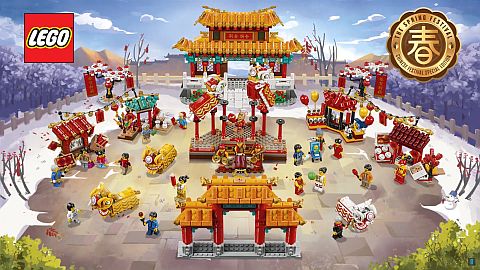
Elements from the #80105 LEGO Chinese New Year Temple Fair set was on top of my list. I absolutely love this set, and it gave me lots of ideas and pieces to work with. I especially wanted to include the beautiful temple building as the central attraction of Chinatown. I also wanted to add my favorite building from Ninjago City; the light-yellow building with the comics shop at the bottom and Lloyd and Misako’s apartment on the third floor. And I wanted a bustling Chinese market that’s hidden from the main street and only locals know of its existence and how to access it. Oh, and I wanted an arcade too, and an Asian style public squatting toilet. Last but not least, I wanted to incorporate some of the amazing printed wall murals/graffiti by EclipseGRAFX, along with their printed tiles and window-panes.
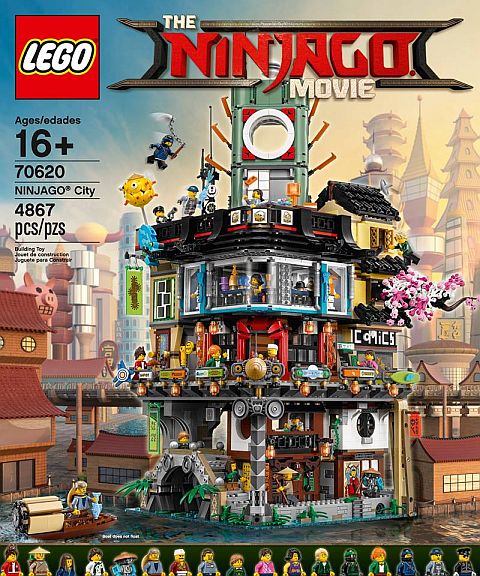
LEGO MODULAR CHINATOWN – THE CREATIVE PROCESS: I still didn’t have any concrete concept about how the whole thing should look together, and ideas continued floating around in my brain. I know many people enjoy this early part of the design process, but I don’t. My head feels like a washing machine churning with ideas – so much so that I get headaches. I also can’t eat, can’t sleep, and can’t focus on anything else. All I can do is keep loading more and more ideas, information, and images into my brain, and hoping that eventually something will start to solidify. Once I have something concrete and I can begin building, I feel much better. Even if the creative process continues and new ideas keep coming, as soon as I can involve my hands, I feel relief. I guess I’m very much a hands-on person. (Please note that the pictures I’m sharing here are of the finished model. The creative process was much more messy!)


LEGO MODULAR CHINATOWN – OTHER INSPIRATIONS: Besides being inspired by modules of the LEGO Ninjago City sets and the LEGO Chinese New Year sets, I also got ideas from other sources. I looked up pictures and videos of Chinatown in Los Angeles (this video was especially helpful), I carefully studied the illustrations in the LEGO Ninjago City instruction booklet (those are great, I wish more instruction books had such images!), and I looked through the details of the Chinese architecture inspired sets by the construction toy brand Xingbao. (This is a branch of Lepin, the company that steals designs from both LEGO and LEGO fans, but they have some pretty neat original designs too, like the Zhonghua Street Collection, which is what I used for inspiration.)

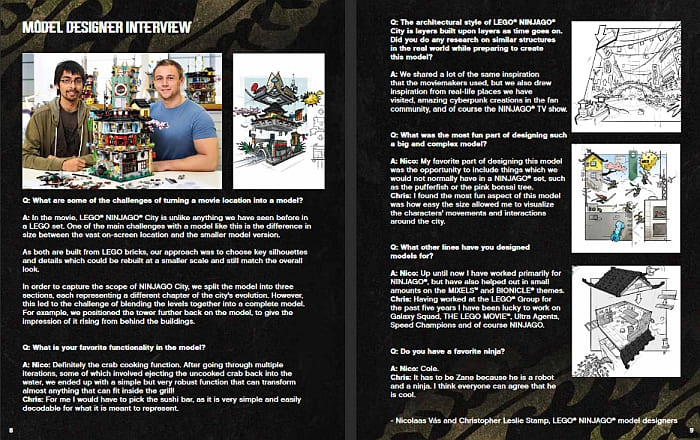
LEGO MODULAR CHINATOWN – THE BUILDING PROCESS: The largest module I wanted to incorporate was the temple from the Chinese New year set, so I built it and started shifting it around a 32×32 baseplate to see how and where it would fit. Then, I got the idea from the #01023 Xingbao Old Style Bank to make the temple into a two-story building with a balcony. So, I made a second roof in the same style, and kind of stacked them on top of each other to see how they would look. At this point, I was pretty sure the second floor is going to be a restaurant.

The temple is 16-studs wide, which left me with another 16 studs for anything else. Since the temple has a flaring roof, I couldn’t put it on edge of the baseplate as it would hang over and run into other buildings. I decided to add simpler buildings on the two sides, to help balance out the over-the-top decorative features of the temple and help tying it together with the rest of the city. Lloyd’s apartment building is 10-studs wide, so that went on one side, which left me with 6 studs on the other side. I wasn’t sure what I will do with such a narrow space, but I knew from the beginning that I wanted it to be very simple gray and white with just a door and window. I like the idea of a plain, unmarked door leading to a colorful and different world. So, it seemed this was destined to be the entry to the hidden Chinese market.


At this stage, I had a two-story façade, and an idea for the structures on the two sides. To keep the momentum going, I started building the next most concrete thing I had in the plan; Lloyd’s apartment building. I wasn’t sure how far back this building will have to sit to fit behind the flared roofs of the temple, but I figured I can always move it back or forward a few studs. The bottom is the comics shop, which I kept as is, except for some extra knickknacks and printed tiles from EclipseGRAFX. I also added two printed posters by EclipseGRAFX next to the entrance. I love these posters so much!
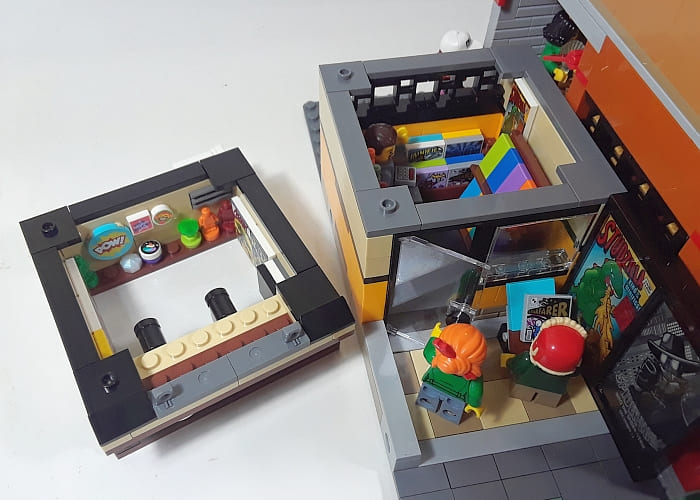
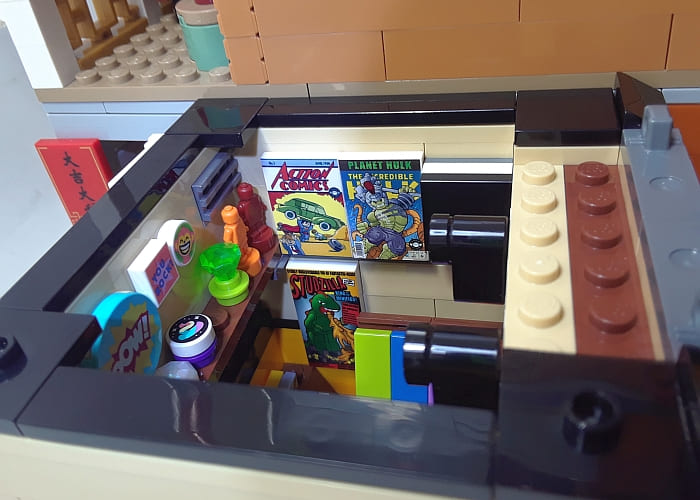
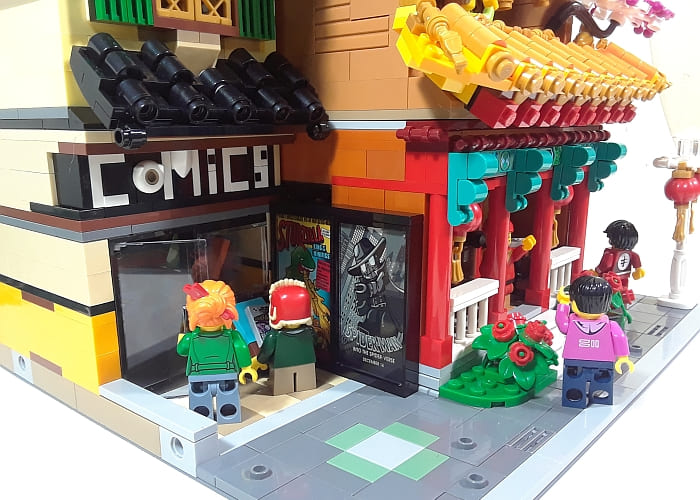
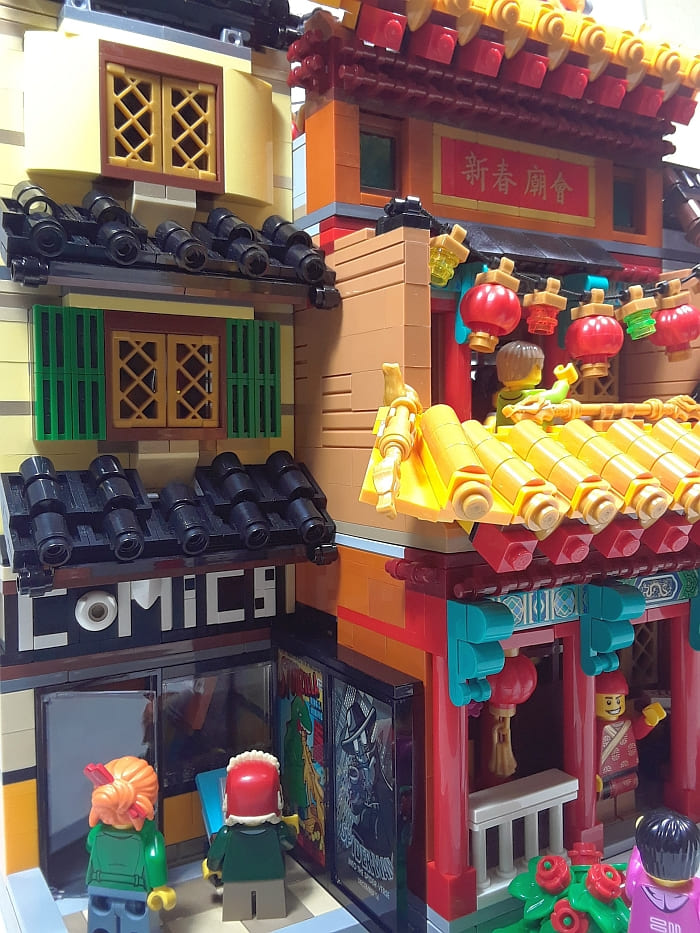
As you may recall, the second story of Lloyd’s apartment building is unfinished in the LEGO Ninjago City set with a tree growing out of it. I restored this section of the building and turned it into another apartment.
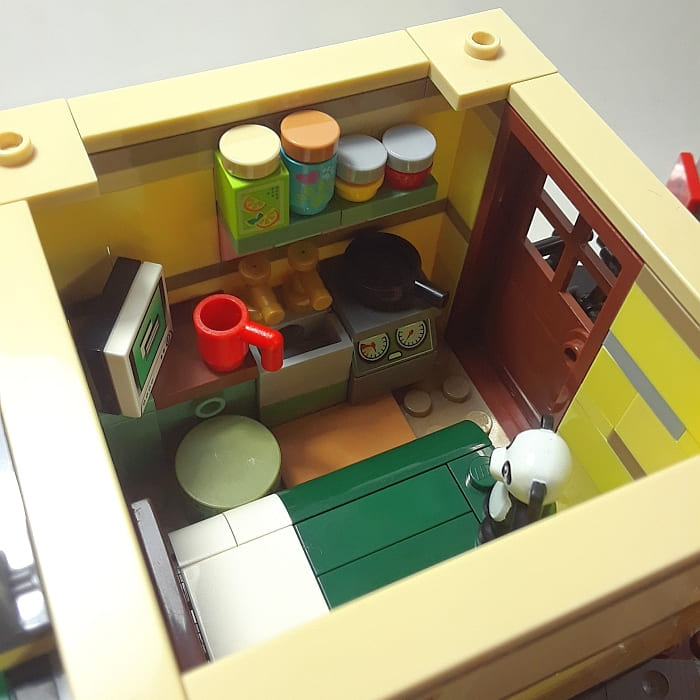
The third story is basically the original Lloyd’s and Misako’s apartment with the awesome bunk bed. I just made some slight changes and upgrades.

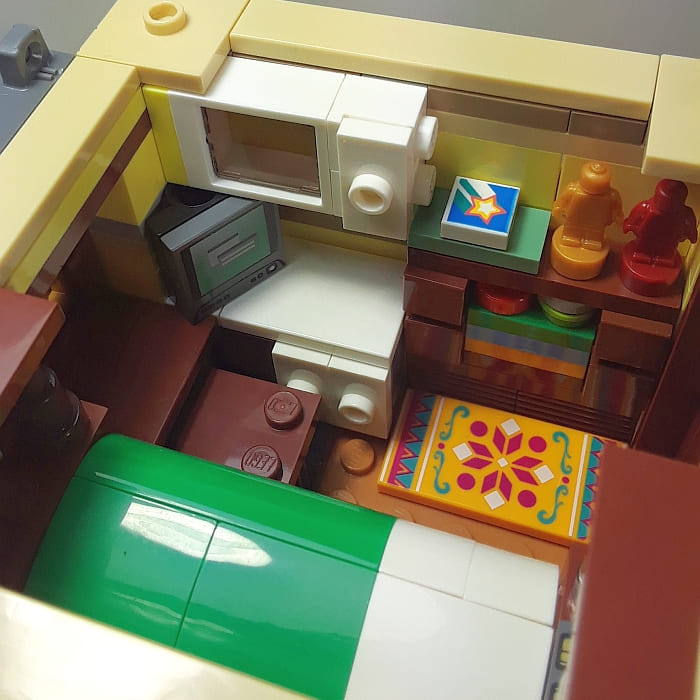
Next, I started thinking about what will go on the bottom floor. The #70657 LEGO Ninjago City Docks has a great little medicine/herbal shop, so I just transferred that over to the left with some slight modifications, and on the right, I made a small tea shop. This started to solidify the shape of the market, and I added a vegetable stall behind the medicine shop and another small stall selling various items behind the tea shop.

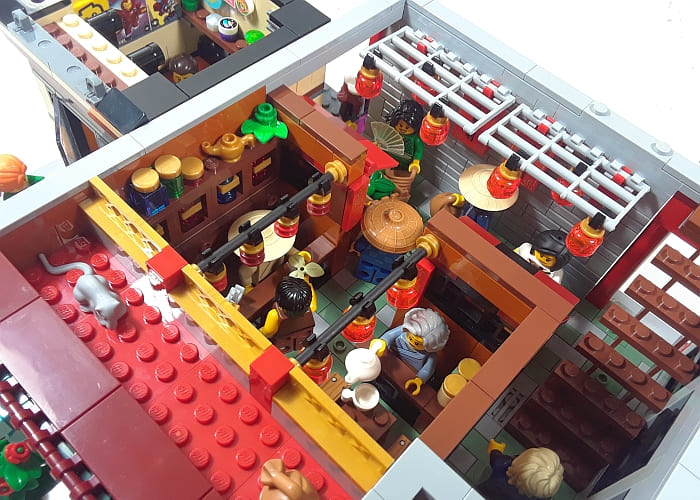
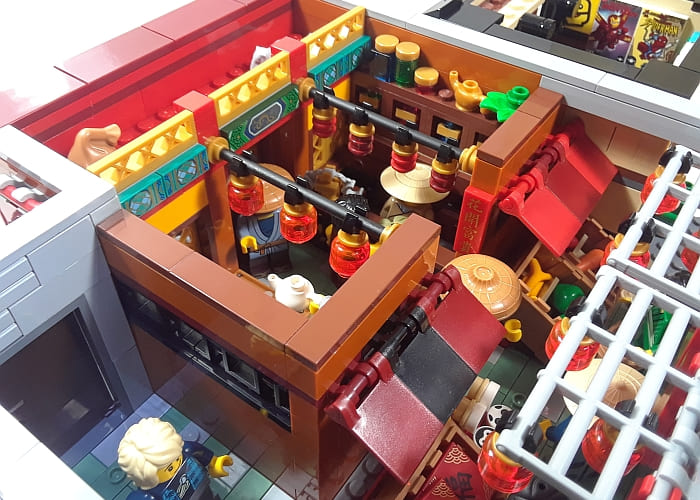
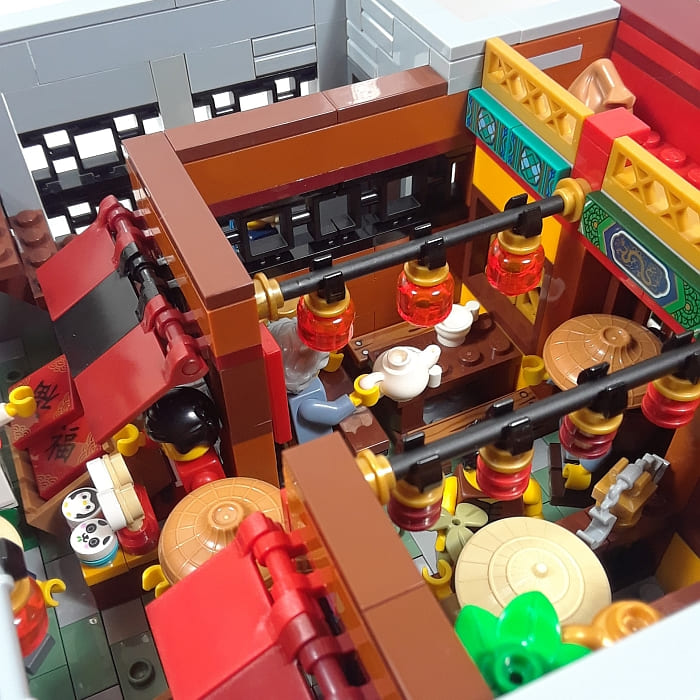
Once all of these were in place, I knew where the back wall was going. And this was a perfect place for the 16-stud wide graffiti by EclipseGRAFX that I really wanted to add. I know that in my layout this won’t show as it’s against the wall, but I know it’s there, and my minifigs know it’s there, and that’s all that matters.
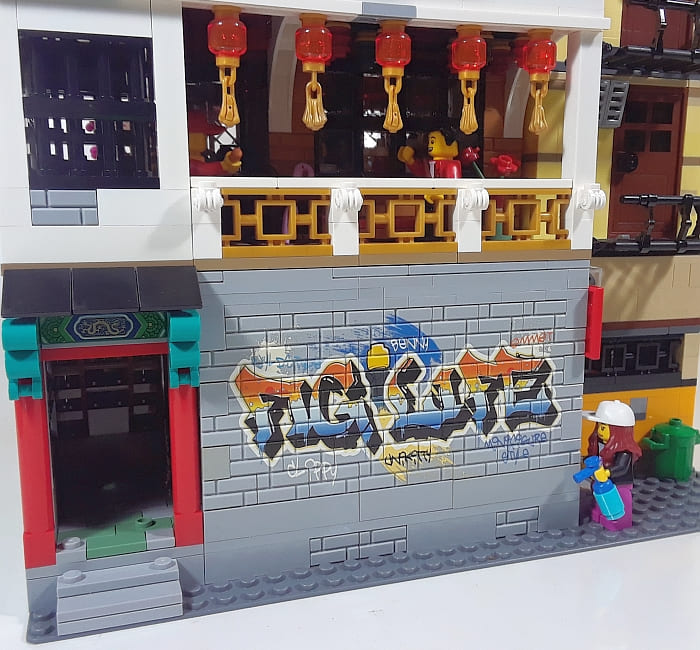
As the marketplace is indoors and kind of dark, I added lots o lanterns. I got the idea of adding a sort of drop-ceiling with the gray barred pieces to hang the lanterns from. They can be turned up to access the market below it.


So, I had Lloyd’s apartment building more or less finished, I had a marketplace on the first floor, and I had an idea to put in a restaurant on the second floor. However, I haven’t worked out how minifigs would get from the first to the second floor, or how the two original temple roof sections will separate to make the building modular with removable floors.

Now that the building is finished, the placement of the staircase looks obvious, but it wasn’t when I built it. This staircase was one of my biggest challenges through the entire building process. I wasn’t sure which way to place the stairs, what kind of stairs they should be, how tall they should go, and where exactly to break the floors to make the building modular with removable sections. After fussing with the stairs for several days, I decided to just finish building the gray and white narrow building, and hope that things will resolve themselves. I added windows to the side, although I know they won’t show as this wall will be pushed against another Modular. But I think it looks nicer than just a plain wall, and it makes the inside more interesting (see picture towards the bottom).

Still struggling with the stairs, I moved on to building the restaurant. Here, I had to figure out how deep to make the balcony, which ended up falling in place once I figured out the placement of the roof section, the columns, the doors and the windows. I originally wanted to include the really cool working grill from the restaurant in the LEGO Ninjago City set, but I later abandoned the idea as it was too big for the space I had. But I still used some of the design elements from the restaurant.
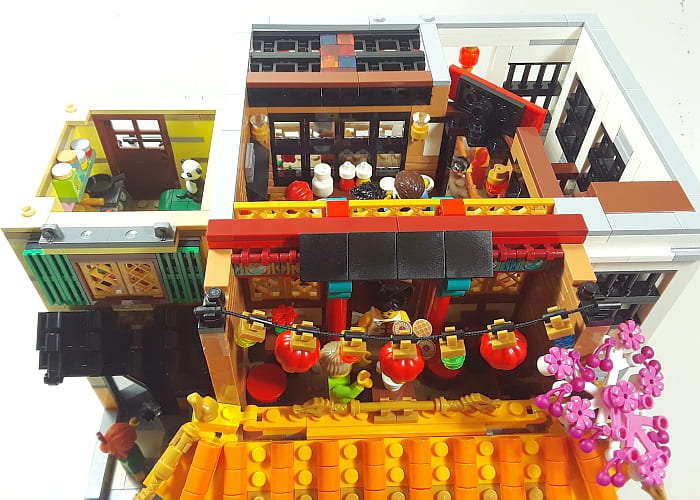
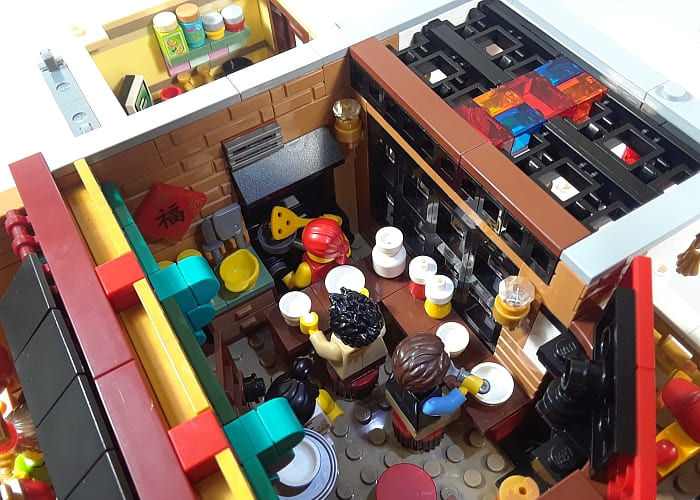
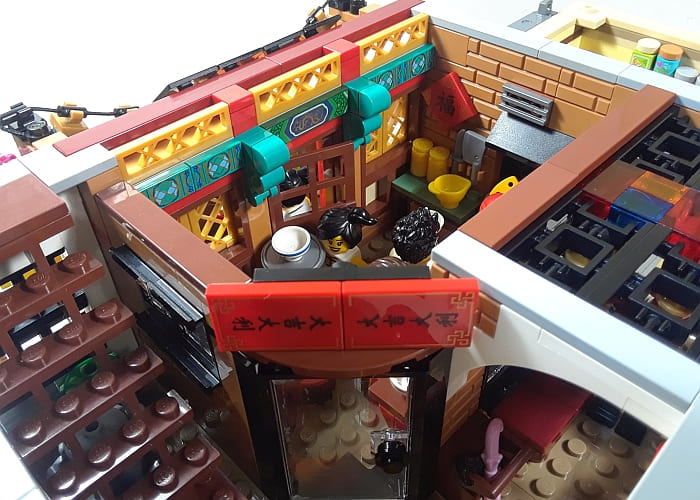
I think it was at this point when the stairs finally figured out where they wanted to go. That was a big relief. But then I had a major hang-up because I wanted to add the Asian squatting toilet under the stairs of the second floor. I worked on this for several days, but then finally let the idea go and just put some garbage cans there. Finishing the stairs did accelerate the building process, and it also established the placement of the second-story walkway. This walkway also has a removable drop-ceiling, but it’s more refined with stained-glass inlays.
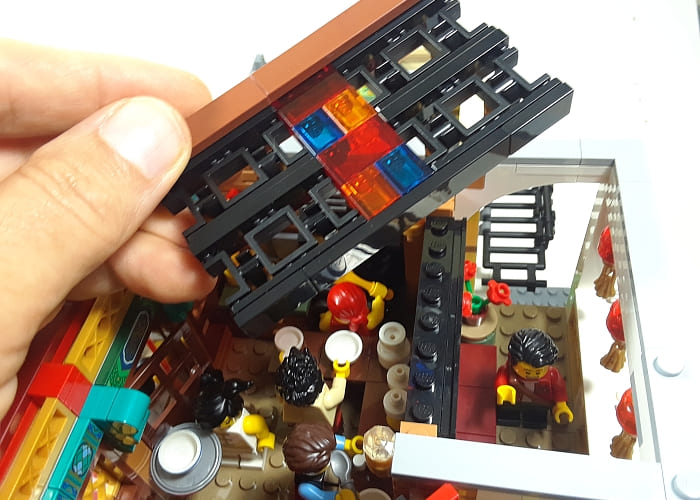
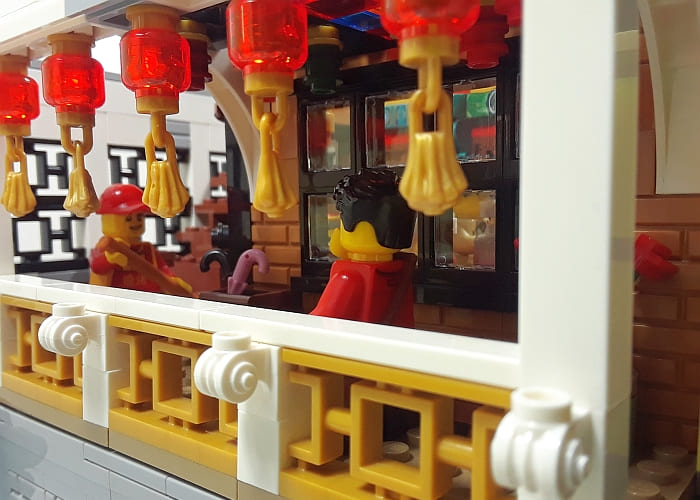
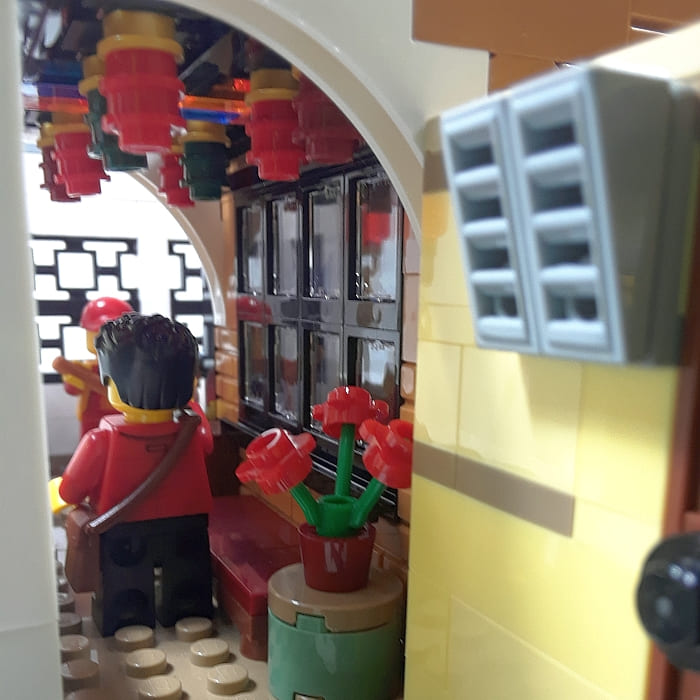
The third floor is an outdoor entertainment area. I really liked the band from the #80104 LEGO Chinese New Year Lion Dance, and the small puppet show theater from the #80105 LEGO Chinese New Year Temple Fair. Both of these were added with some modifications (mostly had to shrink them down to fit the available space).
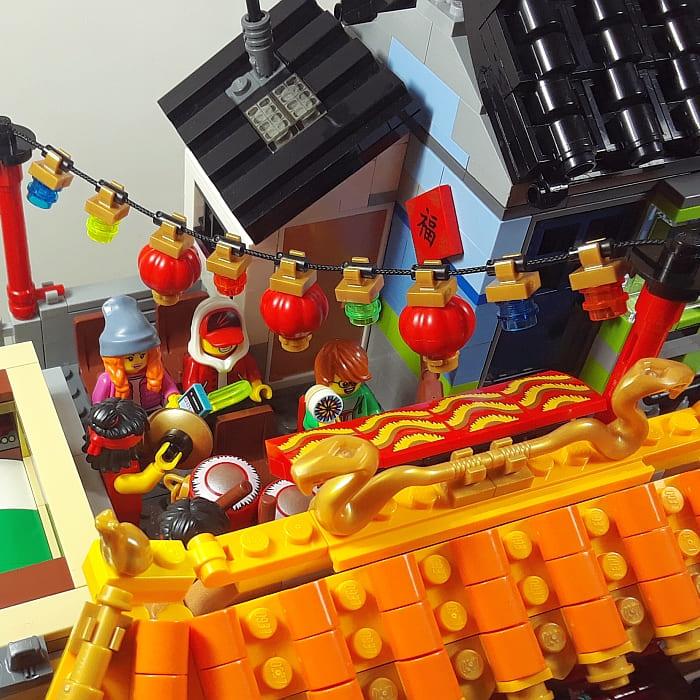

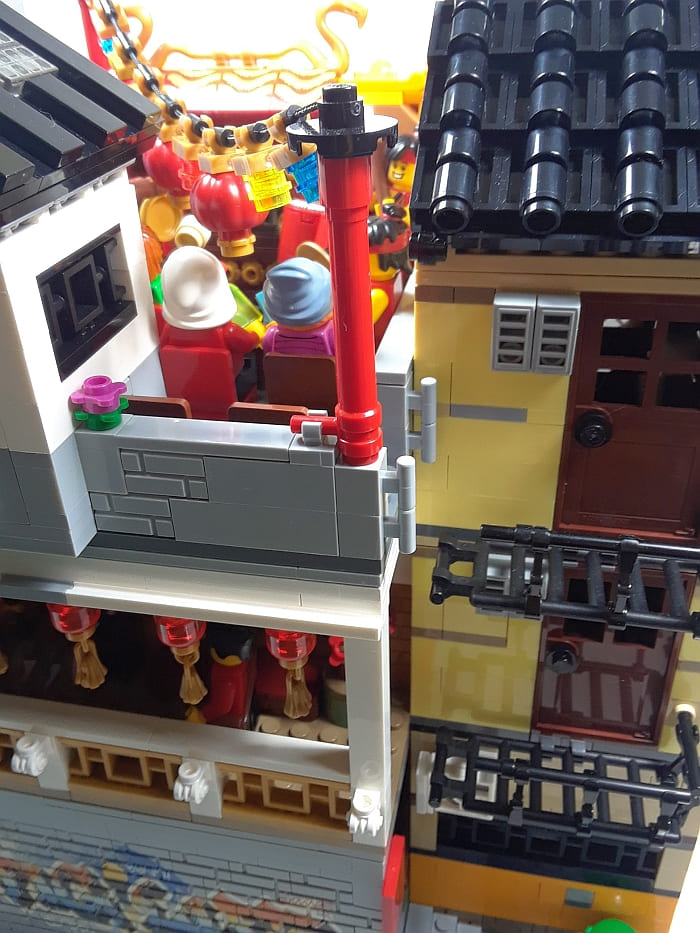
Once I was at this stage, the three-story structure was still not exactly modular. The façade with the elaborate roof sections was all in one piece, although I did work out some break points for the market and the restaurant behind it. I was dreading the idea of going back to the roof sections and finding a workable break point. To my delight though, it wasn’t that hard. I only had to modify the roofs slightly, and I could go back one more time to rebuild each floor with proper break points (I lost count how many times I rebuilt all the floors).
I still wanted to cram an arcade on the third floor somehow, so I began working on that section. This building went through the most modifications in the entire building process. I made it bigger, smaller, square, rectangle, angled, short, tall, door facing left, door facing the front, door facing the back with a catwalk over two stories. And then the bathroom idea resurfaced again, along with the idea of incorporating the working and very cool “monster green soda machine” (as I call it) from LEGO Ninjago City Docks, and another one of EclipseGRAFX graffiti pieces.
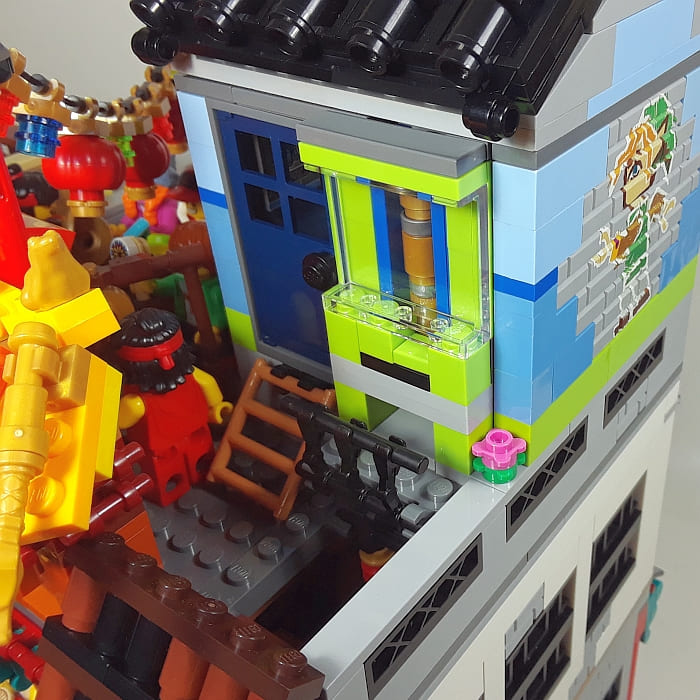
To make the long story short, somehow all these moving parts eventually fell in place, and I ended up with a duplicate of the comics shop for the basic layout for the arcade, with the door facing the front, the “monster green soda machine” next to the entrance, and the squatting toilet attached on the side. (This toilet moved around a lot too, from the original under the staircase idea to behind the arcade, to finally to its current position.) This graffiti is less hidden, especially in its current position next to the LEGO Modular Detective’s Office. I like this graffiti piece a lot.
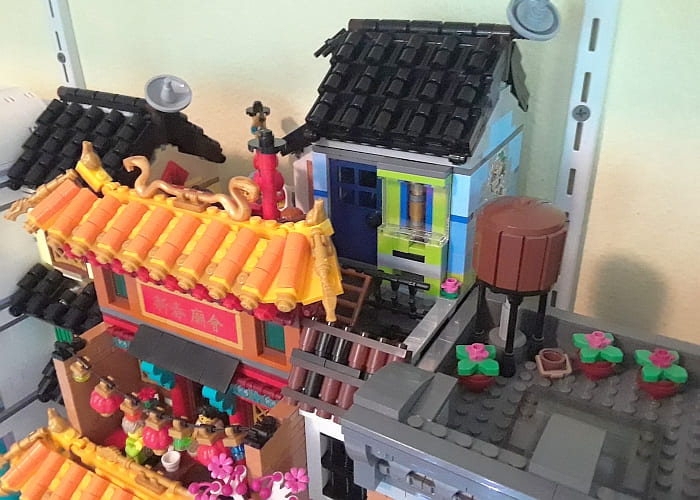
The inside of the arcade is pretty much the same as in LEGO Ninjago City Docks, but I didn’t use any of the original stickers that came with the set. (I don’t use stickers in my LEGO creations – I’m allergic to LEGO stickers, ha-ha!) So I tried to find some printed pieces that would work for the arcade. Right now I’m using the same printed 1x2x2 brick for both arcade machines as that’s all I have, but I’m hoping I will find something better in the future.

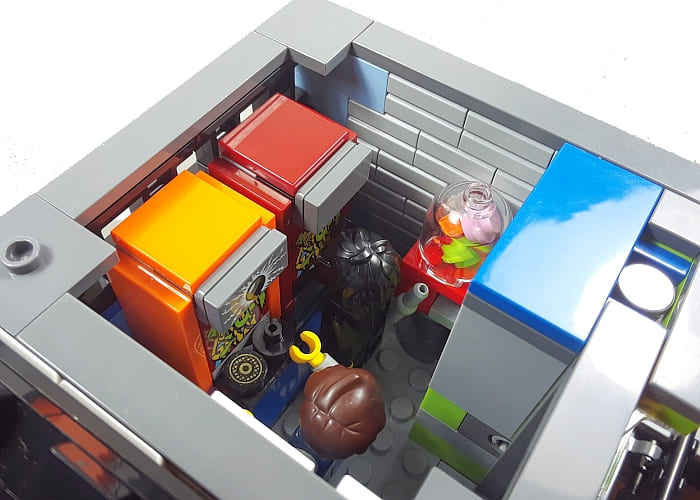
The squatting toilet was originally inspired by the one from LEGO Ninjago City, but it ended up being too big, so I had to make a smaller version. I tried to make the inside of the toilet as obnoxiously colored as possible (printed bricks, tiled floor with weird colors, etc.) As you can probably tell, I haven’t had good experiences with squatting toilets!

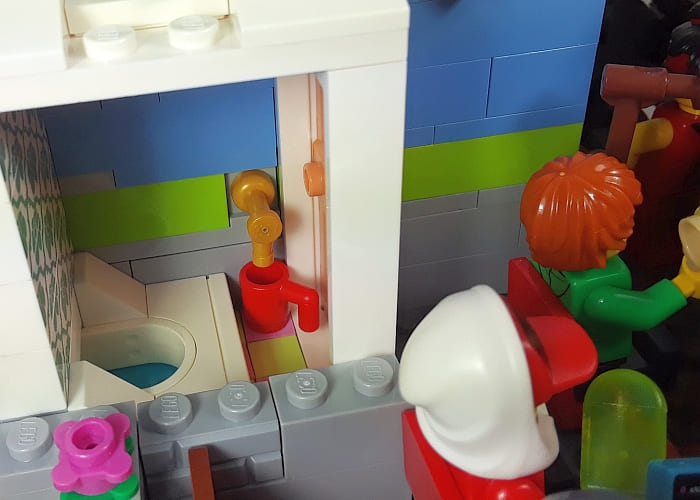
The process of designing and building Chinatown took me about three weeks. Then, there was another week of waiting for some parts I didn’t have from BrickLink.com, then it took another couple of days to go back through the entire build again to fix minor things, replace parts with correct colors/pieces, etc. There are still a few minor changes I would like to make, but other than that, I consider this project done. The minifigs populating Chinatown are mostly from the LEGO Ninjago City sets, and the LEGO Chinese New Year sets, and they seem to like the place. Here are a few additional pictures from all sides.
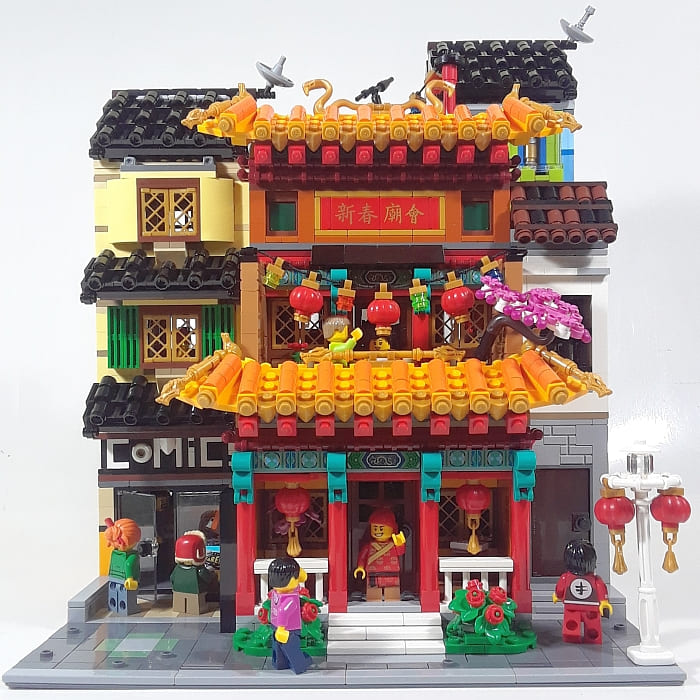
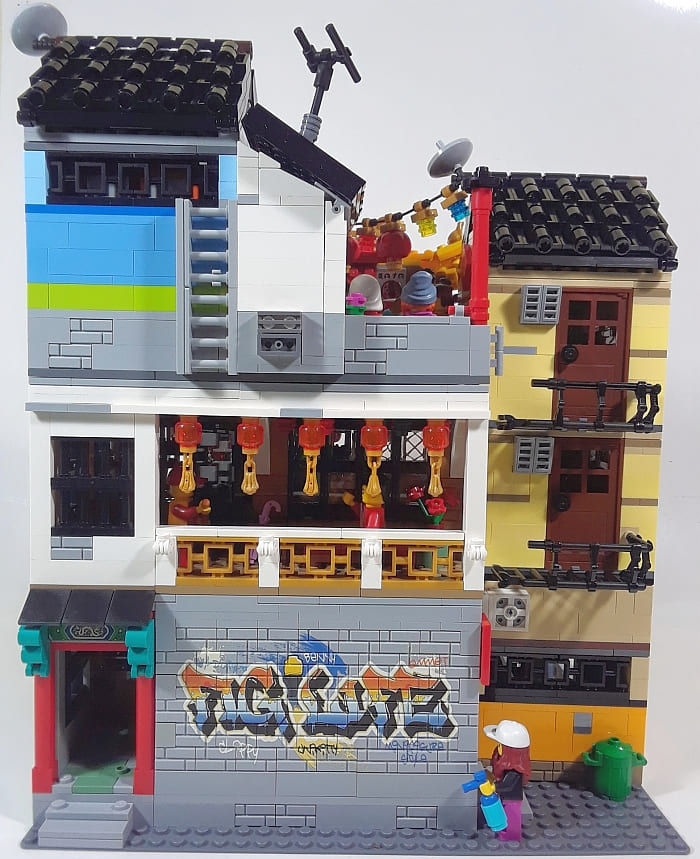
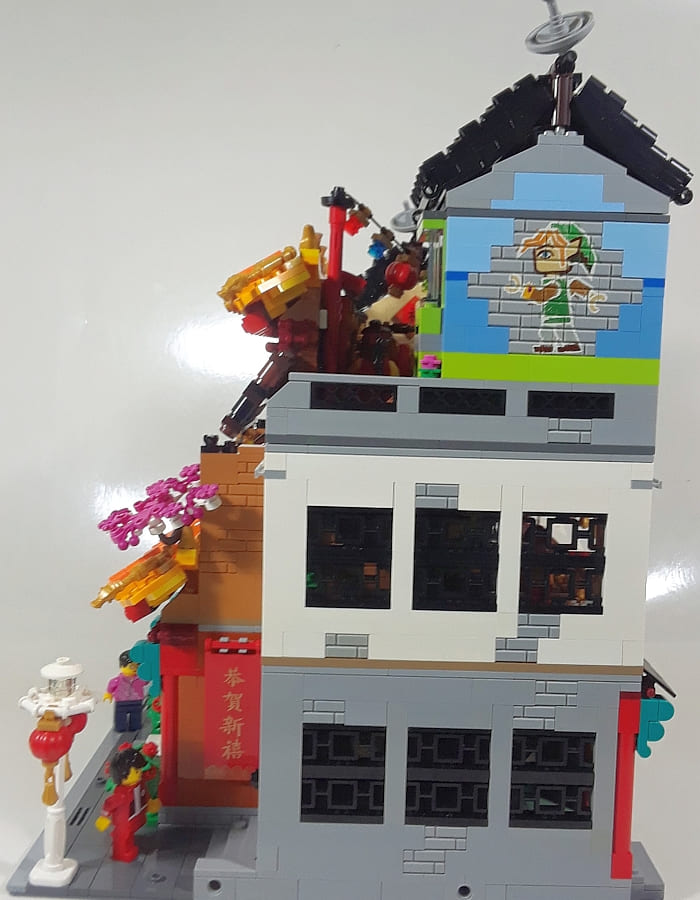
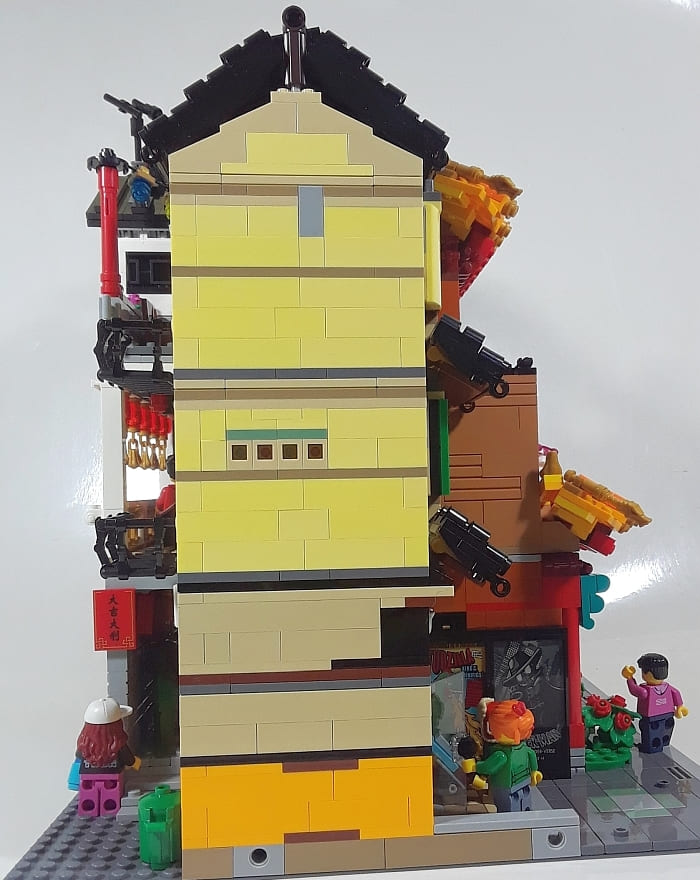
LEGO NINJAGO CHINATOWN – UPS, DOWNS & THE FLOW: I already mentioned that I had major trouble with the staircase, and that the arcade and the bathroom also went through many different stages. Another challenge I ran into was the small walkways/railings at the back of the apartment building. This is another area that may look obvious now, but it took me two days to figure out. Yet another troublesome section was the sign over the restaurant. I’m always hesitant to work with those angled doors because it’s so hard to figure out what to put above them and how. Again, the final solution looks simple, but it took up an entire Saturday to make it happen. So, I would call these the stucked stages or downs.
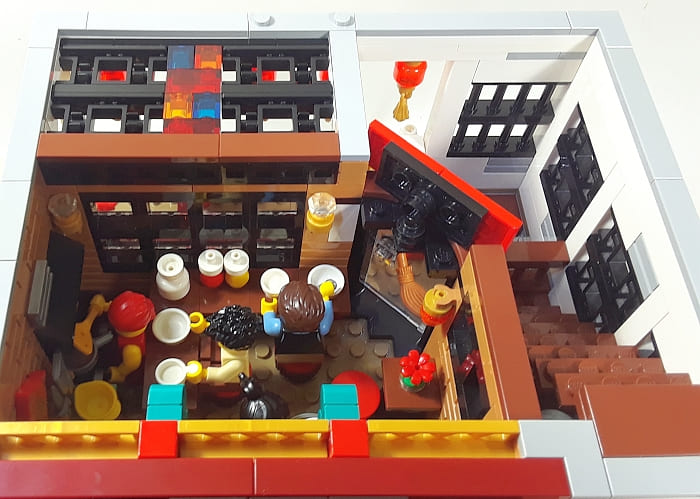
I also mentioned some of the ups, like separating the floors, which I was initially worried about, how perfectly the graffiti fit at the back, the entire marketplace kind of fell in place on its own, and the rooftop scene also came together fairly easily.
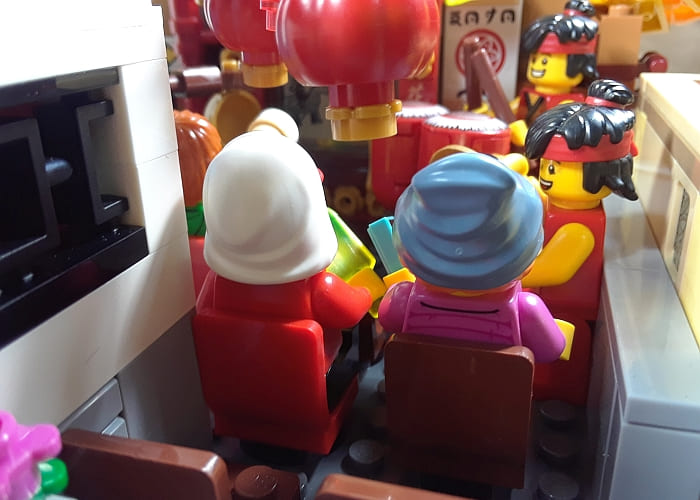
Then there were moments what I consider true inspiration flowing from the realm of the LEGO gods. One was the small cherry tree growing out of the balcony of the restaurant. It just planted itself there from almost the beginning. The other is the roof over the theater, which is made from some printed parts from the LEGO Chinese New Year Lion Dance. Yet another is the Chinese drums one of the musicians play. I didn’t like the one that came with the LEGO Chinese New Year set as it was so big and not the right shape, and I also wanted to use those pretty printed round pieces from the Lions somewhere in the build. I was looking at some real Chinese dance videos on YouTube to see how I could make better drums, got some ideas, looked through the parts I had, and the drums just came together on their own at 2 AM in the morning. It’s one of my favorite parts of the project. The drop-ceiling with the stained-glass inlay was another section that manifested almost on its own. Little experiences like this make taking on a bigger project like this so worthwhile.
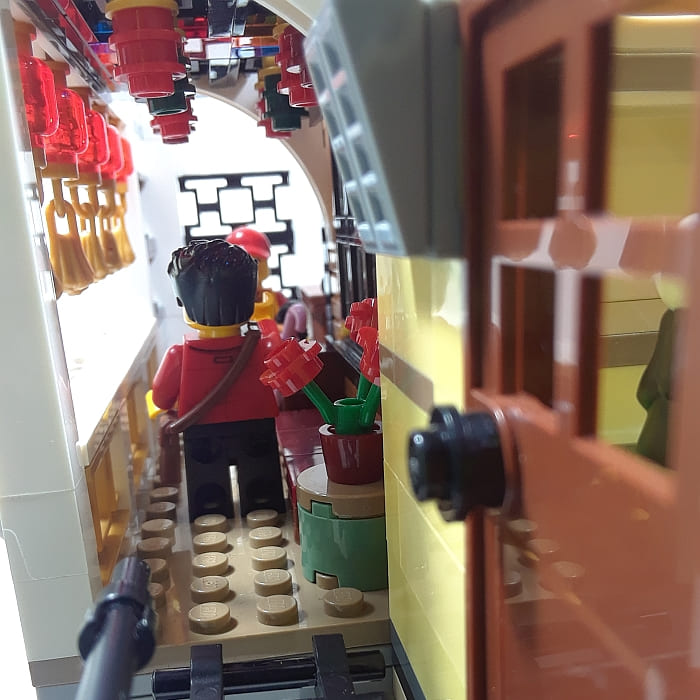
Anyhow, that’s the story of Chinatown. Now I want to build other neighborhoods too! Making your own Modulars is so addicting (and expensive and time-consuming)! Hope you enjoyed reading about the building process, and it gave you some inspiration for your own projects. If you have any questions or comments feel free to add them below. And you’re welcome to share your own building experiences, ups, downs, and little miracles as well!
And you might also like to check out the following related posts:














